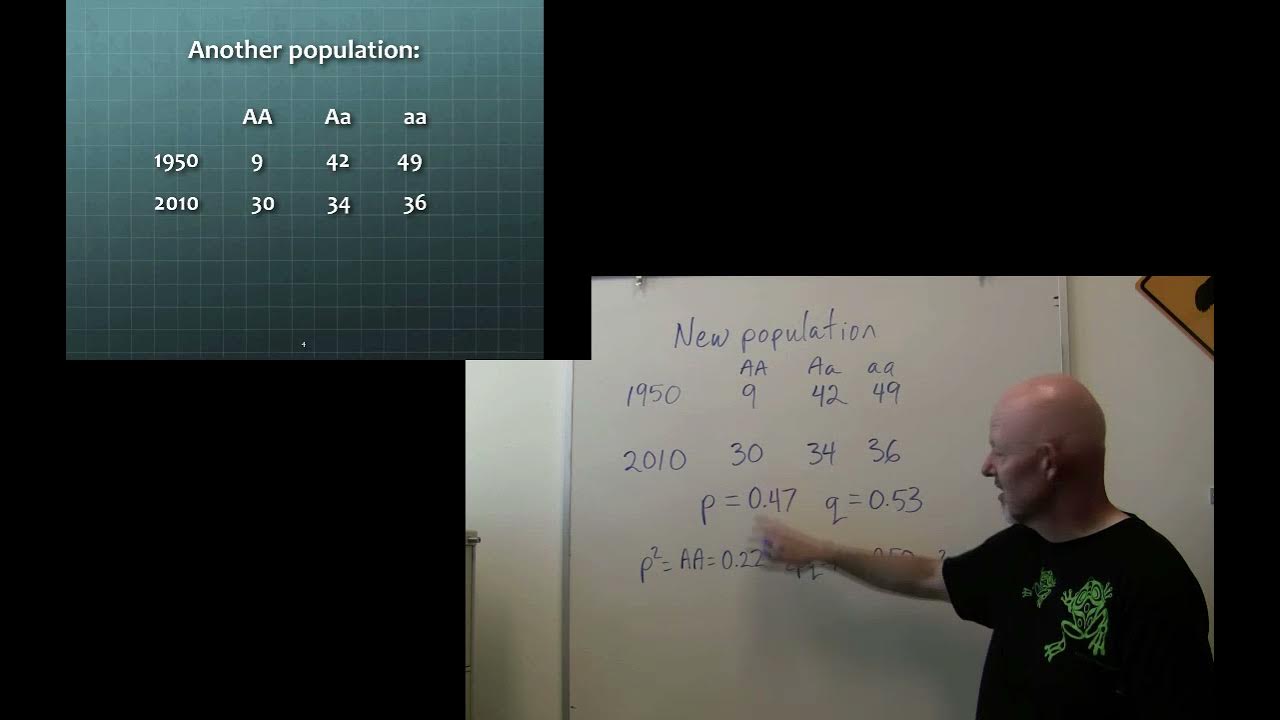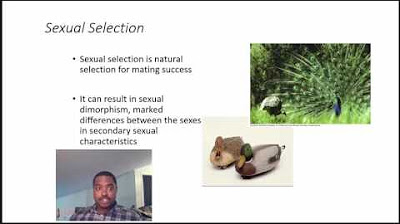Gene drift lab explanation from my lab
Summary
TLDRThis transcript explains genetic drift using a hands-on lab simulation. The process begins with calculating allele frequencies in a population and then simulating random events that lead to the removal of individuals. Through this, the concept of genetic drift is explored, showing how allele frequencies can change in a population purely by chance, without any influence from the fitness of individuals or the advantage of specific alleles. The lab demonstrates how evolution can occur due to random changes in allele frequencies, particularly in small populations. The key takeaway is that genetic drift is a random process that impacts genetic diversity.
Takeaways
- 😀 Genetic drift refers to random changes in allele frequencies due to chance events rather than natural selection.
- 😀 The lab simulates genetic drift by randomly removing individuals from a population and observing changes in allele frequencies.
- 😀 The population starts with 50 individuals, with dominant (big B) and recessive (little b) alleles represented by different colored beads.
- 😀 Initial allele frequencies were 56% for the dominant allele and 44% for the recessive allele.
- 😀 As individuals are randomly removed, the allele frequencies change, and the genetic makeup of the population is altered.
- 😀 Evolution, according to Hardy-Weinberg, occurs when allele frequencies change over time, even without natural selection.
- 😀 The process of removing individuals is not based on their fitness or genotype, but purely by random chance.
- 😀 Genetic drift can lead to significant changes in allele frequencies, especially in smaller populations.
- 😀 The frequency of alleles can increase or decrease randomly, which may eventually lead to allele fixation (the loss of one allele).
- 😀 The lab demonstrates that genetic drift is independent of the fitness of specific alleles, highlighting the randomness of this process.
- 😀 The experiment shows how genetic diversity can be lost over time in small populations due to random events, not selection.
Q & A
What is genetic drift, and how does it differ from natural selection?
-Genetic drift is a random change in allele frequencies due to chance events, especially in small populations. It differs from natural selection, which is a non-random process where alleles increase in frequency based on their survival advantages. Genetic drift does not depend on the fitness of alleles but occurs purely due to random factors.
How is genetic drift demonstrated in the bead simulation?
-In the bead simulation, individuals in a population are represented by black and white beads. Black beads represent the dominant allele (big B) and white beads the recessive allele (little b). By randomly removing certain beads (individuals) from the population, the simulation demonstrates how allele frequencies can change due to chance, not because of any selection pressure.
What does Hardy-Weinberg's principle state about allele frequencies?
-Hardy-Weinberg's principle states that allele frequencies in a population remain constant from generation to generation in the absence of evolutionary forces, such as natural selection, mutation, migration, and genetic drift. Any deviation from this equilibrium suggests that evolution is occurring.
Why does the allele frequency of black beans (big B) increase in the simulation?
-The increase in the frequency of black beans (big B) is due to random chance. In the simulation, certain rows (representing individuals with certain genotypes) are randomly selected for removal. This could result in the survival of individuals with a higher frequency of black beans purely by luck, not because black beans are a better allele for survival.
What is the relationship between population size and genetic drift?
-As the population size decreases, the impact of genetic drift becomes more pronounced. In smaller populations, random events can lead to the loss or fixation of alleles more quickly. This is because there are fewer individuals to carry genetic variation, making random changes in allele frequencies more likely to occur.
Can genetic drift lead to the extinction of alleles?
-Yes, genetic drift can lead to the extinction of alleles. In small populations, random events can result in the complete loss of an allele, particularly if it is not represented in the individuals randomly selected for removal. Over time, this can reduce genetic diversity and potentially lead to the extinction of certain alleles.
Why does the instructor stress that the changes in allele frequencies are due to random chance?
-The instructor emphasizes that allele frequency changes are due to random chance to highlight that genetic drift is not influenced by the adaptive value of alleles. The deaths in the population are not based on the fitness of the individuals but on random events, illustrating how chance alone can drive evolutionary changes in small populations.
What happens when the population is reduced to a very small size in the genetic drift simulation?
-As the population is reduced to a very small size, the likelihood of allele fixation or loss increases. This is because the smaller sample size leads to a greater impact of random events on allele frequencies. In extreme cases, a population could end up with only one allele, completely losing the other.
How does genetic drift impact the gene pool of a population?
-Genetic drift can change the gene pool of a population by randomly altering allele frequencies. As individuals are randomly removed from the population, certain alleles may become more or less common, leading to a shift in the overall genetic makeup of the population.
Does the frequency of the dominant allele (big B) increase because it is beneficial to survival?
-No, the increase in the frequency of the dominant allele (big B) is not due to it being beneficial for survival. The change in frequency is purely a result of random chance, as alleles were removed randomly in the simulation, not due to any selection pressure favoring one allele over another.
Outlines

This section is available to paid users only. Please upgrade to access this part.
Upgrade NowMindmap

This section is available to paid users only. Please upgrade to access this part.
Upgrade NowKeywords

This section is available to paid users only. Please upgrade to access this part.
Upgrade NowHighlights

This section is available to paid users only. Please upgrade to access this part.
Upgrade NowTranscripts

This section is available to paid users only. Please upgrade to access this part.
Upgrade NowBrowse More Related Video
5.0 / 5 (0 votes)





